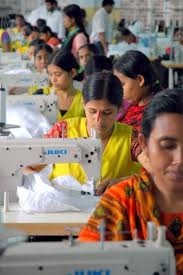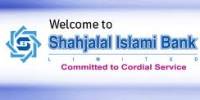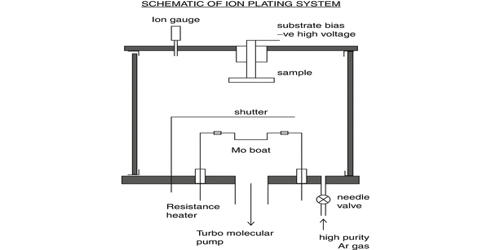Introduction
The major objectives of planned development have been increased national income, rural development, self-sufficiency in food, and increased industrial production. However, progress in achieving development goals has been slow. Political turmoil and untamed natural hazards of cyclone and flooding have combined with external economic shocks to persistently derail economic plans.
In 1991, with the reinstitution of elected government, a new economic program was initiated that included financial sector reform and liberalization measures to encourage investment, government revenue improvement efforts (realized largely through implementation of a value-added-tax), and tight monetary policy. Income transfer measures, Food-for-Work, and other programs were also implemented to help protect the poorest segments of the population from the transitional effects of structural reform.
Fiscal year 2000 was marked by a sharp increase in monetary expansion due to unprecedented borrowing from the banking sector (though the sale of treasury bills) to cover budget shortfalls due. Domestic borrowing increased primarily due to the reduced availability of external concessional financing.
For 2001/02, however, the IMF predicted a sharp decline to around 3.5% due to the global economic slowdown and the contractions after the terrorist attacks of 11 September 2001 on the United States.
Economic Environment
During the early 1990s, Bangladesh made considerable progress in stabilizing and liberalizing its economy. As a result, inflation was much lower than previously, and average annual real GDP growth in 1992-98 was above 5%, largely led by exports involving ready-made garments (RMGs). Indeed, one of the most striking features of Bangladesh’s trade is that textiles and particularly clothing dominate exports: their combined share grew from 70.4% in 1992 to 83.5% in 1998; by contrast, jute, which had previously been Bangladesh’s main export, comprising around half of total exports through the mid-1980s, accounted for only 6% in 1998. This dramatic change in the composition of exports is the consequence of Bangladesh’s increased integration into the multilateral trading system.
Agriculture still accounts for 30% of GDP while employing 63% of total labour force. The RMG-dominated manufacturing sector and services, accounting for 9% and 61% of GDP, respectively, have been the sources of the economy’s growth.
A major development, in March 1994, entailed the liberalization of the exchange regime for current international transactions. However, an appreciating real effective exchange rate has threatened to undermine Bangladesh’s export competitiveness, particularly vis-à-vis South-East Asian garment manufacturers, and therefore constitutes a threat to future export-led growth.
Unfortunately, real annual GDP growth, averaging around 5% during the review period, has not been sufficient to make much of a dent in the poverty that pervades Bangladesh; GDP per capita in 1998/99 was only US$345, among the lowest in the world. More than one third of Bangladesh’s population of 127 million still lives below the poverty line, and more than half is classified as poor. Given Bangladesh’s high incidence of poverty, its dense population, and its vulnerability to natural disasters, including periodic flooding and cyclones, food security is a major policy objective of the Government. Bangladesh is a large recipient of foreign aid, a substantial portion of which entails food.
Growth Development in Bangladesh
Growth averaged 5.4% per year over the FY01-05 period, which has been the highest 5-year average since the country’s independence. Growth was underpinned by:
- Resurgence in private investment, which grew at an annual average rate of 10% and increased its share in GDP from 16% in FY01 to 18.5% in FY05.
- The share of public investment fell from 7% to 6% during the same period.
- Growth has been fairly broad-based, although it has benefited from strong exports, mainly in the garment exports.
- Large remittance inflows fueled growth in construction and services sectors.
- In agriculture, growth has been rather anemic, averaging just 2% over the same period.
On the policy side, a good record on growth seems to have benefited from impressive macro stability. Inflation hasn’t touched double digits for almost two decades, while public and external debt situation is fairly comfortable.
Saving and investment rates, currently at about 24%, are relatively high compared with other countries at similar income levels.
The pace of human development, which is a key contributor to growth and includes progress in health, education and social protection, has surpassed that of most low income countries (LDCs).
Constraints to Growth:
Bangladesh ’s growth challenges are two-fold:
- How to ensure sustainability of the 5-6% growth over the long-term
- How to raise growth to the 7-8% range, which is desirable and needed to meet the government’s poverty reduction goals
The key constraints to improved growth performance include:
Inadequate infrastructure, especially power and ports.
There hasn’t been any increase in generation capacity of power supply for a few years, mainly due to governance-related problems. Bangladesh ’s main port, Chittagong port, is among the most inefficient and cost ineffective in the region.
Governance:
Many important aspects of governance are very weak. Transparency International has ranked Bangladesh last in its corruption ratings for five years in a row. This extracts a significant price in terms of lost growth potential.
Urbanization:
Urbanization has been rapid and largely imbalanced. A quarter of the population now lives in urban areas, while in 1960 the number was just 5%. Fifty percent of GDP is spent on urban activities. Urbanization has been skewed toward Dhaka, making it among the fastest growing metropolises in the world. This is adding to growing concerns about congestion, lagging urban planning and management, and skyrocketing real estate prices.
Export competitiveness:
Bangladesh is one of the most closed economies in the world. Opening up trade has to be one of the pillars of future growth. Growth dividends from trade openness will depend upon concomitant investment climate reforms to boost competitiveness of domestic firms. However, the country should take into account how a reduction in tariffs will affect revenue considering that tariffs constitute about 50% of the already weak tax collection effort.
The financial sector:
Financial depth (measured as M2/GDP) is quite low and the range of financial services quite rudimentary. Many of the important contractual savings institutions are absent, while capital markets are extremely shallow. There is a problem of the “missing middle,” those people who aren’t covered neither by the micro finance institutions nor the formal banking sector. The public banking sector remains riddled with non performing loans, despite recent improvements.
Education:
Despite the impressive improvements, many problems plague the education system. Its quality is weak with a huge rural/urban gap and not relevant to market needs. Tertiary education and vocation studies have been largely neglected. The IT revolution, which has benefited India and, to a lesser extent Pakistan, has largely bypassed Bangladesh.
Achievements of economic development in Bangladesh In different sectors: (Since 1971-2007)
- Bangladesh’s first five-year plan (1973–78) aimed to increase economic growth by 5.5% annually, but actual growth averaged only 4% per year.
- A special two-year plan (1978–80), stressing rural development.
- Projected growth target, as did the second five-year plan (1980–85)
- targeted 7.2% annual growth.
- The third five-year plan (1985–90) had a5.4% annual growth target though only 3.8% was actually achieved.
- Political turmoil from 1994 to 1996 helped reduce the final average annual growth rate under the Fourth Five Year Plan (1990–1995) to 4.15% (short of the 5% target)
- The 1996 elections brought renewed economic stability.
- Economic plan Exports grew 14% 1996, and GDP growth for 1996/97 rose to 5.5% as the economy rebounded.
- Average annual GDP growth under the Fourth Five-Year Plan rose to 5.3%.
- Historically, Bangladesh has received foreign aid disbursements equivalent to about 6% of GDP, have lately declined to amount equaling 3–4% GDP.
- The revenue to GDP ratio rose in 2001 from 8.5% to 9.4%, but this improvement was more than offset by expenditure to GDP ratios of 14.4% and 14.1%, creating budget deficits amounting to 5.9% and 5%, in 2000 and 2001 respectively.
- Domestic borrowing contributed to reducing the foreign exchange cover for imports to imprudent levels of two months in 2000 and one-anda-half months in 2001.
- The drain on foreign reserves from For 2001/02.
- Over 60% of the country’s total land area is cultivated and about 63% of the economically active population derive their livelihood from farming.
- Underweight children under five years old as a percent of the total dropped only 10%, from 66% to 56% between the period 1990–92 and 1998–99.
- Agriculture still accounts for almost 30% of the GDP, although this proportion has dropped significantly from 50% in 1979/80, as services have grown from 34.4% to 52%. Industry’s share has increased only from 15.9% to 18%, according to CIA estimates.
- Political instability and a lack of continued economic reforms pushed inflation to5.2% in 1995.
- Indicators were promising as of 1997, the government’s delay in instituting needed reforms threatened to slow economic advances. Inflation rose to 7%, while GDP had slowed to 4%.
- The economy grew strongly during 1998, real growth reaching 5.4% as flooding, instead of devastating the economy, brought in some much needed foreign aid.
- The military budget in 1996–97 was $559 million or 1.8% of GDP. Bangladesh participated in eight UN peacekeeping missions.
- Saving and investment rates, currently at about 24%, are relatively high compared with other countries at similar income levels.
- A quarter of the population now lives in urban areas, while in 1960 the number was just 5%. Fifty percent of GDP is spent on urban activities.
- Bangladesh is one of the most closed economies in the world. The country should take into account how a reduction in tariffs will affect revenue considering that tariffs constitute about 50% of the already weak tax collection effort.
- The IT revolution, which has benefited India and, to a lesser extent Pakistan, has largely bypassed Bangladesh.
- The government reconstituted the National Women’s Development Council in January 1997, to provide overall guidance on women’s development issues.
Rural Development
More than 50% of the country’s GDP comes from the rural sector. Development of this sector is thus crucial for national development.
Social Welfare
Since poverty alleviation is a major goal of the Government, thrust is being given on socio-economic development of the underprivileged groups. The main emphasis here is on adoption of integrated and comprehensive approach taking the family as the basic unit for social services programs with emphasis on family and group development rather that individual development.
The government has been implementing the following programs in the Social Welfare sector:
(a) Urban and rural community development program.
(b) Development services for the physically and the mentally disabled.
(c) Development services for children.
(d) Welfare services for the juvenile and the distressed women.
(e) Welfare services for the aged and the infirm.
(f) Rehabilitation program for the addicts.
Labor and Employment
The present government has undertaken various measures to expand the opportunities for domestic and overseas employment. Remittances from Bangladeshis working abroad have marked a steep rise during the nineties due to a massive outflow of workers from Bangladesh. As an export item, manpower exports currently occupy the second position with an annual inflow of over 1 billion U.S. Dollars. The Middle Eastern countries along with Malaysia, South Korea and Japan are the principal destination for Bangladeshi workers.
The Labor Policy of the present Government embodies creation of an environment conducive to improved Labor-Management relations in order to provide higher wages through higher productivity, Tipcarts. productivity, provision of incentives, Labor welfare. Employment generation, earnings according to work, and a healthy growth of trade Unionism have been emphasized for ensuring basic needs of all and a balanced economic growth.
Women and Children Affairs
The government is trying hard to integrate the womenfolk of the country into the mainstream of the development process, which is one of the main strategies for overall 50cm-economic development. Poverty, malnutrition, hunger, illiteracy, etc. are largely concentrated around womenfolk, and as such women can act as uniquely suitable agents for elimination of these socio-economic maladies. Attainment of reasonable growth rate, alleviation of poverty through generation of production employment opportunities and development efforts. The government reconstituted the National Women’s Development.
Youth Development
The youths are potentially the most productive force in Bangladesh. They constitute 36% of the total civilian labor force. Recognizing the fact that a disciplined and, organized, trained and educated youth community can make significant contribution to the development process, the government has taken up various programs for their socio- economic uplift.
Education of Bangladesh
Highest allocations for education in the national budgets during the nineties show that the government has attached topmost priority to human resource development though education. The goal of ‘Education for All’ is being vigorously pursued in the country. The education system is divided into 4 levels– Primary (from grades 1 to 5), Secondary (from grades 6 to 10), Higher Secondary (from grades 11 to 12) and tertiary. Alongside national educating system, English medium education is also provided by some private enterprises. They offer ‘A’ level and ‘O’ level courses. There is also Madrasa system which emphasizes on Arabic medium Islam-based education. This system is supervised by the lone Madrasa Board of the country.
There are 11 government universities and approximately 20 private universities in Bangladesh. Specialized universities are Bangladesh University of Engineering and Technology (BUET), Bangladesh Agricultural University and Bangabandhu Shaikh Mujib Medical University.. The number of government and non-government medical colleges stand at 1 3 and 5 respectively. There are 4 engineering colleges, 2845 colleges, institutes, 12553 secondary schools, and 78595 primary schools.
Bangladesh: Housing and Public Works
The Ministry of Housing and Public works is entrusted with the task of carrying out public sector construction activities and looking after urbanization, city development housing settlement aspects throughout the country.
Housing is an important growth sector having backward and forward linkages. Because of ever-increasing demand, the sector the tremendous potentials. A large number of property developers are already active in the private sector.
The state-owned House Building Finance Corporation (HBFC) has been made fully operational for ensuring adequate credit flow to this sector on easy terms. A National Housing policy has been adopted which calls for providing shelter to the poor, the homeless and the needy.
Bangladesh Transport Sector
An efficient transportation system is essential to facilitate economic growth in Bangladesh. The country’s economy needs to grow at a sustained 7 percent per year to achieve the first goal of the MDGs: that of halving the proportion of people living under a dollar a day by 2015. To achieve this growth, the transport sector will need to reduce costs and allocate resources among different modes of transport in a more balanced manner.
Roads.
Roads carry over 80 percent of national passenger traffic, providing the backbone of the transport sector in this country of 140 million people.
Railways.
Bangladesh Railways, primarily a passenger railway, handles approximately 10 percent of the national passenger and freight traffic. It carries its maximum number of passengers between Chittagong and Dhaka, the nation’s most important transport corridor.
Inland waterways.
With some 700 rivers and tributaries crisscrossing the country, Bangladesh has one of the largest inland waterway networks in the world. Inland ports handle about 40 percent of the nation’s foreign trade. The network, which shrinks during the dry season, connects almost all the country’s major cities, towns, and commercial centers. Moreover, being cheap, safe, and environment friendly, inland water transportation is often the only mode that serves the poor, proving especially useful during periods of widespread flooding.
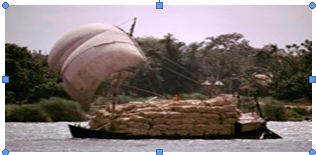
Challenges
- Improvements in the ports, railways and inland container depots in an integrated manner are important so that the Dhaka-Chittagong corridor (the main trade route in Bangladesh) can effectively handle exports and imports. Indicative container handling charges suggest that Chittagong Port (USD200/TEU including unofficial and ancillary costs) is more expensive than other ports in the region.
- To meet the demand of passenger and freight transport, increase in the operational efficiency and safety of Inland Water Transport (IWT) is necessary. IWT currently carries more passengers (13% of total) and freight (25%) than the railways.
- Development of major infrastructure such as the Dhaka Eastern Bypass and the Padma Bridge is important to improve the connectivity and land use of the country. The Eastern Bypass would be a significant investment, comprising transport, flood control, and urban development of Dhaka, which is growing at more than 6 percent per year. The Padma Bridge would connect the currently isolated southwest and the eastern zones of the country.
- Although the road network has been substantially expanded and improved, lack of adequate resource allocation for maintenance threatens its sustainability. Secondly, statistics reveal that the fatality rate is more than 100 deaths per 10,000 registered motor vehicles each year. This is a major area of concern and needs to be addressed. To learn more about road safety in Bangladesh click here .
- Substantial scope exists for introducing private sector management and financing in Bangladesh’s transport sector. Currently, many parstatal transport organizations such as the Bangladesh Inland Water Transport Corporation and the Bangladesh Road Transport Authority are loss making enterprises.
Key Government Strategies
The Government of Bangladesh (GOB), in its Fifth Five Year Plan (1997-2002), states that “an adequate and efficient transport system is a prerequisite for initiating and sustaining economic development”. It also recognizes this fact in other transport policy documents as well as the country’s Poverty Reduction Strategy Paper (PRSP).
In 2004, the GOB approved a National Land Transport Policy to improve the policy and institutional environment for roads and railways in the country. In 2000, a National Shipping Policy was approved to introduce reform and private sector participation in ports and inland waterways. In 2003, a draft Railway Corporate Authority Act was developed to corporatize Bangladesh Railways.
World Bank Support
During the 1990s the World Bank’s lending for transport to Bangladesh was the largest sector investment operation in the country. Since 1990, the Bank has approved six transport projects totaling USD 1.08 billion. Some recent projects include:
- The Dhaka Urban Transport Project (DUTP) has helped address some of the most urgent traffic problems facing Dhaka and improved overall mobility and urban air quality. Given Dhaka’s rapidly growing population and its central role in Bangladesh’s economy, these interventions are critical for sustained economic growth, better public health, a well functioning labor market, and the delivery of basic services to Dhaka’s urban poor. The Strategic Transport Plan, which provides a 5 year investment plan and long term strategic plan for Dhaka’s transport problems, was an important element of the completed DUTP.
The Third Road Rehabilitation and Maintenance Project, aims to reduce the total cost and time of road transportation on Bangladesh’s most traveled roads and to improve critical bottlenecks in the overall transport system by the construction of new road links. These include the Nalka-Hatikamrul-Bonpara Road, the rehabilitation of the Dhaka-Sylhet Road, and the improvement in the Feeder Roads ‘A’ network.
- The Rural Transport Improvement Project aims to provide rural communities with improved access to social services and economic opportunities, and to enhance the capacity of relevant government institutions to better manage rural transport infrastructure in 21 districts of the country.
- The Bangladesh Railway Reform Programmatic Development Policy Credit, was the first major Bank operation in the country’s railway sector. The objective is to improve the governance structure within which Bangladesh Railway operates addressing both governance relationship between the Government and Bangladesh Railway on the one hand, and corporate governance and management structure within the railways organization on the other. This project is one of the flagship projects planned to be developed with the main CAS partners, ADB and JBIC, as part of a multi year, multi donor support program.
Recently the Bank has prepared an Inland Water Strategy Note to provide an overview and assessment of Inland Water Transport in Bangladesh and to help the Government to define a strategy agreed with the stakeholders to bolster the sector’s contribution to shared growth and poverty reduction.
The World Bank plans to continue to support the road sector through the proposed Road Sector Reform Project. Another proposed project, the Export Infrastructure Development Project, will help enhance the country’s trade competitiveness by assisting the Chittagong Port to construct a modern Inland Container Depot near Dhaka.
The World Bank and the IFC have lately started dialogue with the government to facilitate modernization, restructuring and commercialization of the national flag carrier, Bangladesh BIMAN.
BANGLADESH: Transport Sector Key Statistics | ||
Particulars | Units | As of 2006 |
| Length of Roads | Km. | 270,565 |
| Main Roads | Km. | 20,735 |
| Paved Roads | % | 29 |
| Access to All-Season-Roads* | % | 39 |
| Road Density – LAND | km/1,000 sq. km. | 1,662 |
| Rail Track Length | Km. | 3973.49 |
| Total No. of Ports | 2 | |
| Turnaround Time | Days | 3.10 |
| Total No. of Airports | 10 | |
| International | 2 | |
Bangladesh
The Human Development Index – going beyond income
Each year since 1990 the Human Development Report has published the human development index (HDI) which looks beyond GDP to a broader definition of well-being. The HDI provides a composite measure of three dimensions of human development: living a long and healthy life (measured by life expectancy), being educated (measured by adult literacy and enrolment at the primary, secondary and tertiary level) and having a decent standard of living (measured by purchasing power parity, PPP, income).
The HDI for Bangladesh is 0.547, which gives the country a rank of 140th out of 177 countries with data (Table 1).
| Table 1: Bangladesh’s human development index 2005 | ||||
| HDI value | Life expectancy at birth (years) | Adult literacy rate (% ages 15 and older) | Combined primary, secondary and tertiary gross enrolment ratio (%) | GDP per capita (PPP US$) |
| 1. Iceland (0.968) | 1. Japan (82.3) | 1. Georgia (100.0) | 1. Australia (113.0) | 1. Luxembourg (60,228) |
| 138. Lesotho (0.549) | 126. Mauritania (63.2) | 126. Nepal (48.6) | 137. Equatorial Guinea (58.1) | 136. Sudan (2,083) |
| 139. Congo (0.548) | 127. Lao People’s Democratic Republic (63.2) | 127. Central African Republic (48.6) | 138. Nigeria (56.2) | 137. Uzbekistan (2,063) |
| 140. Bangladesh (0.547) | 128. Bangladesh (63.1) | 128. Bangladesh (47.5) | 139. Bangladesh (56.0) | 138. Bangladesh (2,053) |
| 141. Swaziland (0.547) | 129. Solomon Islands (63.0) | 129. Bhutan (47.0) | 140. Yemen (55.2) | 139. Lao People’s Democratic Republic (2,039) |
| 142. Nepal (0.534) | 130. Turkmenistan (62.6) | 130. Senegal (39.3) | 141. Togo (55.0) | 140. Zimbabwe (2,038) |
| 177. Sierra Leone (0.336) | 177. Zambia (40.5) | 139. Burkina Faso (23.6) | 172. Niger (22.7) | 174. Malawi (667) |
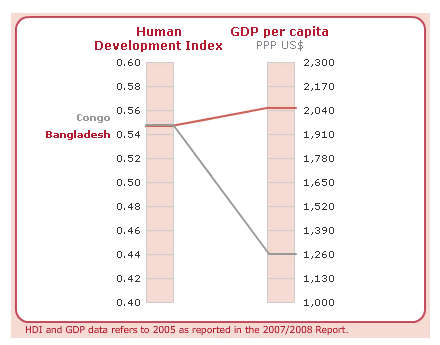
This year’s HDI, which refers to 2005, highlights the very large gaps in well-being and life chances that continue to divide our increa. Figure 2 illustrates that countries on the same level of HDI as Bangladesh can have very different levels of income. singly interconnected world.
(Figure 2). East Asia and South Asia have accelerated progress since 1990. Central and Eastern Europe and the Commonwealth of Independent States (CIS), following a catastrophic decline in the first half of the 1990s, has also recovered to the level before the reversal. The major exception is sub-Saharan Africa. Since 1990 it has stagnated, partly because of economic reversal but principally because of the catastrophic effect of HIV/AIDS on life expectancy.
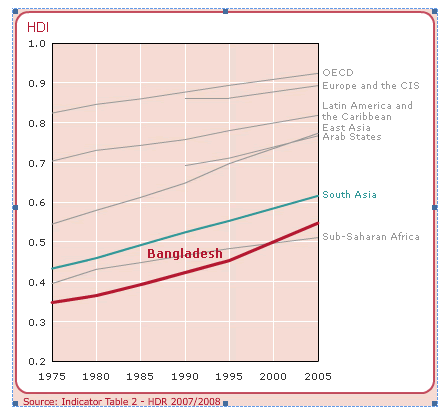
Human poverty in Bangladesh: focusing on the most deprived in multiple dimensions of poverty
The HDI measures the average progress of a country in human development. The Human Poverty Index for developing countries (HPI-1), focuses on the proportion of people below a threshold level in the same dimensions of human development as the human development index – living a long and healthy life, having access to education, and a decent standard of living. By looking beyond income deprivation, the HPI-1 represents a multi-dimensional alternative to the $1 a day (PPP US$) poverty measure.
The HPI-1 value of 40.5 for Bangladesh, ranks 93rd among 108 developing countries for which the index has been calculated.
| Table 2: Selected indicators of human poverty for Bangladesh | ||||
| Human Poverty Index (HPI-1) 2004 | Probability of not surviving past age 40 (%) 2004 | Adult illiteracy rate (%ages 15 and older) 2004 | People without access to an improved water source (%) 2004 | Children underweight for age (% ages 0-5) 2004 |
| 1. Chad (56.9) | 1. Zimbabwe (57.4) | 1. Burkina Faso (76.4) | 1. Ethiopia (78) | 1. Nepal (48) |
| 14. Timor-Leste (41.8) | 50. Lao People’s Democratic Republic (16.6) | 10. Senegal (60.7) | 42. Malawi (27) | 2. Bangladesh (48) |
| 15. Gambia (40.9) | 51. Guyana (16.6) | 11. Bhutan (53.0) | 43. Rwanda (26) | 3. India (47) |
| 16. Bangladesh (40.5) | 52. Bangladesh (16.4) | 12. Bangladesh (52.5) | 44. Bangladesh (26) | 4. Yemen (46) |
| 17. Côte d’Ivoire (40.3) | 53. Turkmenistan (16.2) | 13. Central African Republic (51.4) | 45. Ghana (25) | 5. Timor-Leste (46) |
| 18. Zimbabwe (40.3) | 54. Solomon Islands (16.1) | 14. Nepal (51.4) | 46. Central African Republic (25) | 6. Burundi (45) |
| 108. Barbados (3.0) | 173. Iceland (1.4) | 164. Estonia (0.2) | 125. Hungary (1) | 134. Chile (1) |
Building the capabilities of women
The HDI measures average achievements in a country, but it does not incorporate the degree of gender imbalance in these achievements. The gender-related development index (GDI), introduced in Human Development Report 1995, measures achievements in the same dimensions using the same indicators as the HDI but captures inequalities in achievement between women and men. It is simply the HDI adjusted downward for gender inequality. The greater the gender disparity in basic human development, the lower is a country’s GDI relative to its HDI.
Bangladesh’s GDI value, 0.539 should be compared to its HDI value of 0.547. Its GDI value is 98.5% of its HDI value. Out of the 156 countries with both HDI and GDI values, 107 countries have a better ratio than Bangladesh’s.
Fighting climate change
As a result of past emissions of carbon dioxide (CO2) and other greenhouse gases (GHGs), the world is now on course for future climate change.If these trends continue, the carbon budget will be set for expiry during the 2030’s, setting in motion processes that can lead to temperature increases of 5ºC or above by the end of this century—roughly similar to temperature changes since the last ice age 10,000 years ago.
| Table 4: Carbon dioxide emissions | ||||||||
| Total emissions (MtCO2) | CO2 emissions annual change (%) | CO2 emissions share of world total (%) | Population share (%) | CO2 emissions per capita (tCO2) | ||||
| CO2 emitters | 1990 | 2004 | 1990-2004 | 1990 | 2004 | 2004 | 1990 | 2004 |
| United States | 4,818.3 | 6,045.8 | 1.8 | 21.2 | 20.9 | 4.6 | 19.3 | 20.6 |
| China | 2,398.9 | 5,007.1 | 7.8 | 10.6 | 17.3 | 20.2 | 2.1 | 3.8 |
| Russian Federation | 1,984.1 | 1,524.1 | -1.9 | 8.8 | 5.3 | 2.2 | 13.4 | 10.6 |
| India | 681.7 | 1,342.1 | 6.9 | 3.0 | 4.6 | 17.4 | 0.8 | 1.2 |
| Iran (Islamic Republic of) | 218.3 | 433.3 | 7.0 | 1.0 | 1.5 | 1.1 | 4.0 | 6.4 |
| Pakistan | 68.0 | 125.6 | 6.0 | 0.3 | 0.4 | 2.4 | 0.6 | 0.8 |
| Bangladesh | 15.4 | 37.1 | 10.1 | 0.1 | 0.1 | 2.4 | 0.1 | 0.3 |
| Nepal | 0.6 | 3.0 | 27.3 | 0.0 | 0.0 | 0.4 | 0.0 | 0.1 |
| Maldives | 0.2 | 0.7 | 26.5 | 0.0 | 0.0 | 0.0 | 0.7 | 2.5 |
| Bhutan | 0.1 | 0.4 | 15.9 | 0.0 | 0.0 | 0.0 | 0.1 | 0.2 |
| Global aggregates | ||||||||
| High-income OECD | 10,055.4 | 12,137.5 | 1.5 | 44.3 | 41.9 | 14.3 | 12.0 | 13.2 |
| Least developed countries | 74.1 | 146.3 | 7.0 | 0.3 | 0.5 | 11.8 | 0.2 | 0.2 |
| South Asia | 990.7 | 1,954.6 | 7.0 | 4.4 | 6.7 | 24.4 | 0.8 | 1.3 |
| Medium human development | 5,944.4 | 10,215.2 | 5.1 | 26.2 | 35.2 | 65.1 | 1.8 | 2.5 |
| World | 22,702.5 | 28,982.7 | 2.0 | 100.0 | 100.0 | 100.0 | 4.3 | 4.5 |
The Great War of Liberation and the Emergence of an Independent Bangladesh:
The military junta of Yahya Khan started a dialogue with the leader of the majority party, Bangabandhu Sheikh Mujibur Rahman. But it was actually an attempt to hoodwink the Bangalees-the junta was taking time t make their military preparations complete for a fnal crackdown. They smuggled in arms and ammunition from West Pakistan and a large number of army personne, too. On March 25, at midnight, they led a sudden attack on the unarmed Bangalees in Dhaka and other places. Thus began the so-called ‘Operation Searchlight’, the most heinous and barbarous genocide in the history of mankind. A little after the midnight in the early hours of March 26, 1971, Bangabandhu delcared the independence of Bangladesh. He sent a message containing the declaration of independence to his party leaders in Dhaka and Chittagong over the wireless of the then East Pakistan Rifles.
“The Pakistani Army has launched a sudden attack on the EPR Headquarters at Pilkhana and the Police Line at Rajarbagh and they have killd many people in the city. Street fights are going on in Dhaka and Chittagong. Our freedom fighters are viliantly fighting for liberating their motherland from the enemies. In the name of Almighty Allah, this is my appeal andorder to you-seek the assistance from the Police, the EPR, the Bengal Regiment and the Ansars to liberate the country. No compromise; the victory must be ours. Expel the last enemy from our sacred motherland. Reach this message to all Awami League leaders and workers and all other patriotic and freedom loving people. May Allah bless you. You Bangla.”
The Post-liberation period & the struggle for national reconstruction
After the Liberation, Bangabandhu and the Awami League government faced a formidable challenge in the sphere of nationalThe government reconstituted the National Women’s Development Council in January 1997, to provide overall guidance on women’s development issues. reconstruction. The whole country was ravaged by the non-month long bloody War of Liberation. Communication system, the posts and industries were completely in ruins. Schools and colleges, factories and food silos, the village hats and bazar were burnt to ashes by the marauding Pakistani soldiers. All these things had to be rebuilt. Then there was the staggering problem of the rehabilitation of the families of the martyr, of those who were maimed by the War and of the women raped and tortured by the Pak army. Ten million refugees, who had fled to India, were to be brought back and rehabilitated. The economy was in a shambles, foreign currency reserve was nil,
The food silos were empty. The possibility of a famine causing death of millions was being forecast. Things were compounded by the drought of 1972, the devastating cyclone of 1973, the adverse effect of the worldwide recession owing to the Arab-Israeli War and the floods of 1974 etc. A greater threat to the political stability of the newborn country was posed by the conspiracies of the defeated anti-liberation quarters. A few pro-Chinese leftists started a nefarious campaign by setting jute godowns on fire, uprooting railway tracks, attacking police outposts and committing clandestine political murders. The government of Bangabandhu had to confront these challenges of reconstruction on a War footing.
On his return from his confinement in Pakistan on January 10, 1972, Bangabandhu devoted himself to this stupendous task of reconstruction. We can enumerate the successes of the Bangabandhu government of 3 years briefly as follows:
(a) Restoration of communication system within the shortest possible time; the clearing of mines at Chittagong and Chalna Ports;
(b) Rehabilitation of 10 million refugees who had taken shelter in India;
(c) Granting of economic aid to the families of martyred freedom fighters;
(d) Rehabilitation of narly 3 lakh women who were dishonoured during the War;
(e) Sending of disabled freedom-fighters abroad for treatment
(f) Ensuring the return of the Indian forces within 3 months of the Liberation;
(g) Framing of one of the world’s best constitutions within 10 months;
(h) Introduction of Parliamentary system;
(i) Holding of general elections in 1973 (AL won 293 out of 300 seats);
(j) Reorganization of the Defence Forces;
(k) Appointment of the Kudrat-e-Khuda Education Commission for framing a scientific and secular education policy;
(l) The promulgation of a democratic ordinance for the universities (1973);
(m) Nationalization of 40 thousand primary schools;
(n) Winning of recognition by 140 nations of the world;
(o) Siging the Ganges-Water Sharing Treaty with India ensuring 44,000 cusecs of water for Bangladesh; etc, etc.
In 1974, when the anti-liberation forces accelerated their disruptive activities Bangladesh felt the necessity of uniting all the pro-Liberation forces of the country under one banner. With this end in view, he formed the Bangladesh Krishak-Sramik Awami League (24 January, 1975). He also declared the programme called the ‘Second Revolution’ in order to rivitalize the economy and to cement the national unity. As a result of this, the law and order situation improved considerably; the prices of essential commodities came down and political stability returned to the country.
At this critical juncture, when Bangladesh was striding forward under the able leadership of Bangabandhu Sheikh Mujibur Rahman, the cruelest assassination of history took place on August 15, 1975
Conclusion
The fate of Bangladesh and the Bangalee nation has been enextricably interwined with this party. It has always upheld and fought for the democratic ideals and stood by the side of the toiling masses.
Our great leader, Bongobondhu Sheikh Mujibur Rahman did his politics all for the betterment of the lot of the poor masses of this country.
After his sad death, the mantle has fallen on his daughter, Sheikh Hasina, who is carrying on the same fight as her father.
